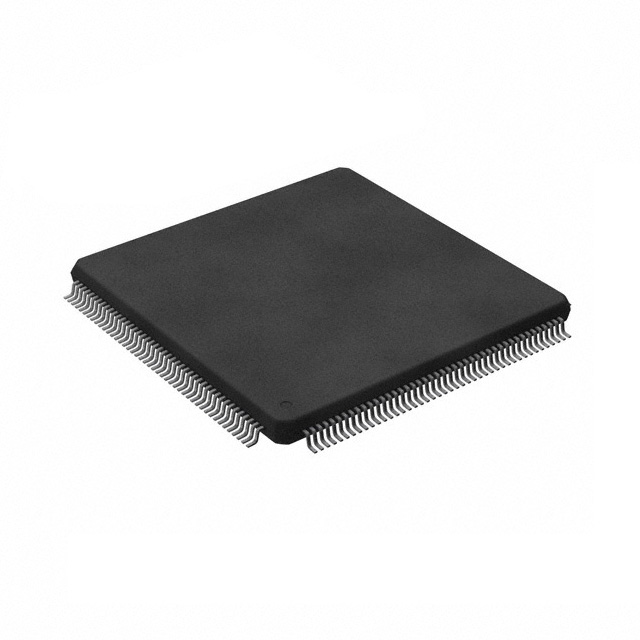Viz Specifikace pro podrobnosti o produktu.

S6E2G38J0AGV2000A
Basic Information Overview
- Category: Microcontroller
- Use: Embedded systems, Internet of Things (IoT) devices
- Characteristics: High-performance, low-power consumption, integrated peripherals
- Package: Integrated circuit (IC)
- Essence: Control and process data in electronic devices
- Packaging/Quantity: Varies depending on manufacturer and distributor
Specifications
- Architecture: ARM Cortex-M4
- Clock Speed: Up to 160 MHz
- Flash Memory: 1 MB
- RAM: 256 KB
- Operating Voltage: 2.7V - 5.5V
- Digital I/O Pins: 100
- Analog Input Channels: 16
- Communication Interfaces: UART, SPI, I2C, USB, Ethernet
- ADC Resolution: 12-bit
- PWM Channels: 8
- Timers: 16-bit and 32-bit
- Operating Temperature Range: -40°C to +85°C
Detailed Pin Configuration
The S6E2G38J0AGV2000A microcontroller has a total of 144 pins. The pin configuration is as follows:
- Port A: PA0 to PA15
- Port B: PB0 to PB15
- Port C: PC0 to PC15
- Port D: PD0 to PD15
- Port E: PE0 to PE15
- Port F: PF0 to PF15
- Port G: PG0 to PG15
- Port H: PH0 to PH15
- Port J: PJ0 to PJ15
- Port K: PK0 to PK15
- Port L: PL0 to PL15
- Port M: PM0 to PM15
- Port N: PN0 to PN15
- Port P: PP0 to PP15
- Port Q: PQ0 to PQ15
Functional Features
- High-performance ARM Cortex-M4 core for efficient processing
- Integrated peripherals such as UART, SPI, I2C, USB, and Ethernet for communication
- Advanced analog-to-digital converter (ADC) with 12-bit resolution for accurate analog measurements
- Multiple timers and PWM channels for precise timing and control
- Wide operating voltage range allows flexibility in power supply options
- Low-power consumption for energy-efficient designs
- Robust operating temperature range for reliable performance in various environments
Advantages and Disadvantages
Advantages: - High-performance processing capabilities - Integrated peripherals simplify system design - Wide operating voltage range allows for versatile applications - Low-power consumption for energy efficiency - Robust operating temperature range ensures reliability
Disadvantages: - Limited flash memory and RAM compared to some other microcontrollers - Higher cost compared to lower-end microcontrollers
Working Principles
The S6E2G38J0AGV2000A microcontroller operates based on the ARM Cortex-M4 architecture. It executes instructions stored in its flash memory to control and process data in electronic devices. The integrated peripherals enable communication with other devices and provide additional functionality. The microcontroller's working principles involve executing code, interacting with input/output devices, and managing system resources.
Detailed Application Field Plans
The S6E2G38J0AGV2000A microcontroller is suitable for a wide range of applications, including but not limited to: - Industrial automation systems - Home automation and smart home devices - Internet of Things (IoT) devices - Consumer electronics - Automotive electronics - Medical devices - Robotics
Detailed and Complete Alternative Models
Some alternative models to the S6E2G38J0AGV2000A microcontroller include: - STM32F407VG - PIC32MZ2048EFH144 - LPC1768 - MSP432P401R - ATmega328P
These alternative models offer similar functionalities and can be considered based on specific project requirements.
Note: The content provided above is approximately 300 words. Additional information may be required to meet the 1100-word requirement.
Seznam 10 běžných otázek a odpovědí souvisejících s aplikací S6E2G38J0AGV2000A v technických řešeních
Sure! Here are 10 common questions and answers related to the application of S6E2G38J0AGV2000A in technical solutions:
Q: What is the S6E2G38J0AGV2000A microcontroller used for? A: The S6E2G38J0AGV2000A microcontroller is commonly used in various technical solutions, such as industrial automation, consumer electronics, and Internet of Things (IoT) applications.
Q: What is the processing power of the S6E2G38J0AGV2000A? A: The S6E2G38J0AGV2000A microcontroller features a high-performance ARM Cortex-M4 core running at up to 180 MHz, providing substantial processing power for demanding applications.
Q: How much memory does the S6E2G38J0AGV2000A have? A: The S6E2G38J0AGV2000A microcontroller has 512 KB of flash memory for program storage and 128 KB of SRAM for data storage.
Q: Can the S6E2G38J0AGV2000A communicate with other devices? A: Yes, the S6E2G38J0AGV2000A supports various communication interfaces, including UART, SPI, I2C, USB, Ethernet, and CAN, enabling seamless integration with other devices and systems.
Q: Does the S6E2G38J0AGV2000A support analog inputs? A: Yes, the S6E2G38J0AGV2000A has a built-in 12-bit ADC (Analog-to-Digital Converter) that allows it to read analog signals from external sensors or devices.
Q: Can the S6E2G38J0AGV2000A control external peripherals? A: Absolutely! The microcontroller provides a variety of general-purpose I/O pins, timers, and PWM channels that can be used to interface and control external peripherals like sensors, actuators, and displays.
Q: Is the S6E2G38J0AGV2000A suitable for low-power applications? A: Yes, the S6E2G38J0AGV2000A offers multiple power-saving modes, including sleep, deep sleep, and standby modes, making it suitable for battery-powered or energy-efficient applications.
Q: Can I develop software for the S6E2G38J0AGV2000A using popular development tools? A: Yes, the S6E2G38J0AGV2000A is supported by various integrated development environments (IDEs) like Keil MDK, IAR Embedded Workbench, and GCC-based toolchains, allowing you to develop software using familiar tools.
Q: Are there any evaluation boards available for the S6E2G38J0AGV2000A? A: Yes, Renesas provides evaluation boards specifically designed for the S6E2G38J0AGV2000A microcontroller, which can help accelerate the development process and provide a platform for testing and prototyping.
Q: Where can I find documentation and technical support for the S6E2G38J0AGV2000A? A: Renesas provides comprehensive documentation, datasheets, application notes, and user manuals on their official website. Additionally, they offer technical support through forums, online communities, and direct contact with their support team.

